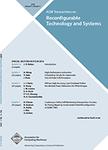版权所有:内蒙古大学图书馆 技术提供:维普资讯• 智图
内蒙古自治区呼和浩特市赛罕区大学西街235号 邮编: 010021

作者机构:Univ Kassel Dept Elect Engn & Comp Sci Kassel Germany
出 版 物:《ACM TRANSACTIONS ON RECONFIGURABLE TECHNOLOGY AND SYSTEMS》 (ACM Trans. Reconfigurable Technol. Syst.)
年 卷 期:2025年第18卷第1期
页 面:1-36页
核心收录:
学科分类:08[工学] 0812[工学-计算机科学与技术(可授工学、理学学位)]
主 题:Design tools Electronic design automation Energy efficiency Hardware compiler Optimisation Reconfigurable systems
摘 要:The end of Moore s law and Dennard scaling emphasizes the need for application-specific computing architectures to achieve high resource and energy efficiency and real-time performance. The concept of a silicon compiler remains an enduring aspiration for design time reduction. In order to generate hardware implementations at register transfer level from behavioral descriptions, design automation tools must address challenging and interdependent problems, including allocation, scheduling, and binding. Additionally, manual intervention by the user is necessary to balance the resources vs. performance tradeoff via, for example, function inlining or loop unrolling/pipelining. Existing approaches typically solve these problems sequentially, compromising optimality in favor of simplicity and runtime. Here we show how to model the whole model-based design flow as one holistic integer linear programming (ILP) formulation aiming at consistently deriving the optimal microarchitecture for any given application. Incorporating clock gating minimizes the number of useless operations with negligible resource overhead (if any), while always guaranteeing optimal throughput. The unified nature of the proposed ILP model enables implementations unmatched by state-of-the-art approaches in terms of resource efficiency and measured power consumption. These results facilitate a streamlined design flow for highly optimized embedded systems in the context of model-based design.